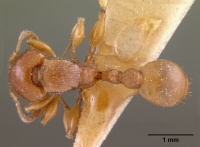Terataner luteus
| Terataner luteus | |
|---|---|

| |
| Scientific classification | |
| Kingdom: | Animalia |
| Phylum: | Arthropoda |
| Class: | Insecta |
| Order: | Hymenoptera |
| Family: | Formicidae |
| Subfamily: | Myrmicinae |
| Tribe: | Crematogastrini |
| Genus: | Terataner |
| Species: | T. luteus |
| Binomial name | |
| Terataner luteus (Emery, 1899) | |
Identification
Bolton (1981) - The four known species of the luteus-complex are confined to the forests of West and Central Africa. The complex is diagnosed by the short straight frontal carinae which fade out on the head behind the level of the eyes, fine sculpture, and sparse pilosity on the body; the tibiae lack standing hairs. Of the species thus defined two, Terataner elegans and Terataner luteus, have a broad flattened postpetiole, the posterior dorsal margin of which is broad and very broadly, evenly rounded. The other two species, Terataner piceus and Terataner velatus, have the posterior arch of the postpetiole narrow and narrowly rounded in dorsal view. T. elegans and luteus are very closely related, being separated mainly on colour (luteus is uniformly yellow), and on the dimensions of the pronotum. Apart from this the pronotum of luteus in dorsal view usually has the lateral margins more strongly convex than in elegans, though in smaller individuals this difference is often unapparent.
luteus - Colour uniform dull yellow. Pronotum broader than long, the pronotal width about equalling or distinctly exceeding the combined lengths of the pro- and mesonotum in dorsal view. At least in larger specimens the sides of the pronotum in dorsal view distinctly convex. Ground-sculpture on dorsum of head very feeble, sometimes almost effaced.
elegans - Colour blackish brown to black on head and gaster, alitrunk reddish or lighter brown. Pronotum about as long as broad, the pronotal width less than the combined lengths of the pro- and mesonotum in dorsal view. In all specimens the sides of the pronotum in dorsal view only very feebly convex. Ground-sculpture on dorsum of head superficial but dense and distinct.
Keys including this Species
Distribution
Latitudinal Distribution Pattern
Latitudinal Range: -2.33162° to -2.33162°.
| North Temperate |
North Subtropical |
Tropical | South Subtropical |
South Temperate |
- Source: AntMaps
Distribution based on Regional Taxon Lists
Afrotropical Region: Cameroun (type locality), Central African Republic, Congo, Ghana, Nigeria, Uganda.
Distribution based on AntMaps
Distribution based on AntWeb specimens
Check data from AntWeb
Countries Occupied
| Number of countries occupied by this species based on AntWiki Regional Taxon Lists. In general, fewer countries occupied indicates a narrower range, while more countries indicates a more widespread species. |

|
Estimated Abundance
| Relative abundance based on number of AntMaps records per species (this species within the purple bar). Fewer records (to the left) indicates a less abundant/encountered species while more records (to the right) indicates more abundant/encountered species. |

|
Biology
Castes
Worker
Images from AntWeb
   
| |
| Type of Atopomyrmex luteus. Worker. Specimen code casent0104610. Photographer April Nobile, uploaded by California Academy of Sciences. | Owned by ZMHB, Berlin, Germany. |
    
| |
| Worker. Specimen code casent0102051. Photographer April Nobile, uploaded by California Academy of Sciences. | Owned by MSNG, Genoa, Italy. |
Nomenclature
The following information is derived from Barry Bolton's Online Catalogue of the Ants of the World.
- luteus. Atopomyrmex luteus Emery, 1899e: 477 (w.) CAMEROON.
- Type-material: holotype worker.
- Type-locality: Cameroon: (no further data) (Conradt).
- Type-depository: MSNG.
- [Note: a specimen labelled “type” in MCZC is not mentioned in the original description.]
- Combination in Terataner: Emery, 1912b: 103.
- Status as species: Stitz, 1910: 145; Emery, 1912b: 103; Wheeler, W.M. 1922a: 885; Emery, 1924d: 242; Bolton, 1981b: 293 (redescription); Bolton, 1995b: 403.
- Distribution: Cameroon, Ghana.
Unless otherwise noted the text for the remainder of this section is reported from the publication that includes the original description.
Description
Worker
Bolton (1981) - TL 5.0-5.8, HL 1.22-1.40, HW 1.16-1.32, CI 94-98, SL 0.74-0.80, SI 59-66, PW 0.86-1.04, AL 1.52-1.78 (15 measured).
Type Material
Syntype workers, Cameroun (Conradt) (Museo Civico di Storia Naturale, Genoa, Museum of Comparative Zoology) [examined].
References
- Bolton, B. 1981. A revision of six minor genera of Myrmicinae (Hymenoptera: Formicidae) in the Ethiopian zoogeographical region. Bulletin of the British Museum (Natural History) Entomology. 43:245-307. PDF (page 293, see also)
- Emery, C. 1899d. Fourmis d'Afrique. Ann. Soc. Entomol. Belg. 43: 459-504 (page 477, worker described)
- Emery, C. 1912b. Études sur les Myrmicinae. [I-IV.]. Ann. Soc. Entomol. Belg. 56: 94-105 (page 103, Combination in Terataner)
References based on Global Ant Biodiversity Informatics
- Bolton B. 1981. A revision of six minor genera of Myrmicinae (Hymenoptera: Formicidae) in the Ethiopian zoogeographical region. Bulletin of the British Museum (Natural History). Entomology 43: 245-307.

